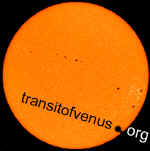 http://www.astro.uni-bonn.de/~dfischer/skyreports/2004/venus.html
http://www.astro.uni-bonn.de/~dfischer/skyreports/2004/venus.html
The Astronomical Unit from differential astrometry of
the 2004 Transit of Venus? by Daniel Fischer. "Based on a handful
of medium-quality photographs of the full solar disk taken during the 2004
transit of Venus, a first attempt to derive the AU by relative astrometry to two
sunspots in AR 627 is made."
 http://www.dsellers.demon.co.uk/venus/ven_ch1.htm
http://www.dsellers.demon.co.uk/venus/ven_ch1.htm
A tutorial on the transit of Venus as a technique for measuring solar parallax
and quantifying the Astronomical Unit; excerpts with illustrations from the book "The Transit of Venus & the
Quest for the Solar Parallax" by David Sellers.
 http://home.hetnet.nl/~smvanroode/venustransit/eng/eng_parallax.html
http://home.hetnet.nl/~smvanroode/venustransit/eng/eng_parallax.html
Measure the distance to the sun by knowing only your location (lat/long) and the
time(s) of internal contact. That is, "compute the mean equatorial
solar parallax online from your own and others’ observations of the 2004
transit of Venus, employing either Halley’s or Delisle’s method."
This is the easiest method for casual observers to quantify the distance to the
sun from their own data..
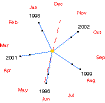 http://dspace.dial.pipex.com/town/estate/vs76/trans.htm
http://dspace.dial.pipex.com/town/estate/vs76/trans.htm
An explanation of the frequency of Venus transits by Peter M. Langford.
 http://sunearth.gsfc.nasa.gov/sunearthday/2004/index_vthome.htm
http://sunearth.gsfc.nasa.gov/sunearthday/2004/index_vthome.htm
An extensive collection of Sun-Earth Day resources from the fun folks at
the Sun-Earth Connection Education Forum.
 http://eclipse.astroinfo.org/transit/venus/project2004/pub/Blatter.etal.eng.200306.pdf
http://eclipse.astroinfo.org/transit/venus/project2004/pub/Blatter.etal.eng.200306.pdf
Venustransit 2004: Calculation of the Solar Parallax from Observations by
Heinz Blatter. Detailed math "gives an overview of the geometry and
temporal patterns of transits, a rough estimate of the solar parallax and the
corresponding error estimate. The possible and necessary corrections due to the
rotation of the Earth, the eccentricities of the orbits of Venus and Earth and
the inclination of the orbit of Venus are given as well." June 2003.
 blackdrop.htm
blackdrop.htm
The "Black Drop" Effect page addresses
in detail the phenomenon at internal contact which has confounded astronomers
for years.
http://www.vt-2004.org/Background/Infol2/EIS-B4.html
Approximated method for the calculation of the parallax (with examples); from
Venus Transit 2004 consortium. .
 Compute the mean equatorial solar parallax online from your own and others'
observations of the 2004 transit of Venus, employing Halley's method; courtesy
of Steven M. van Roode.
Compute the mean equatorial solar parallax online from your own and others'
observations of the 2004 transit of Venus, employing Halley's method; courtesy
of Steven M. van Roode.
![[IMAGE: Calculation of PP']](stern.gif) http://www.phy6.org/stargaze/Svenus2.htm
http://www.phy6.org/stargaze/Svenus2.htm
"Approximate calculation of the AU based on the June 8 transit of Venus,
meant for the level of high school or beginning college and uses only algebra
and simple trigonometry. It only relies on simulated data--specifically,
predicted times of 2nd and 3rd contact for Cairo and Durban;" from David P.
Stern.
http://merlin.alleg.edu/employee/d/doneal/articles/transit.html
Introduction to the transit of Venus; from Douglas O'Neil.
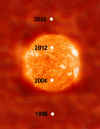
Illustrations suggest Venus transits the sun in 2004 and 2012 but misses the sun
in other years when it is near the nodes. Not to scale; orbital
inclination is exaggerated. See the Transit
Frequency activity for details.
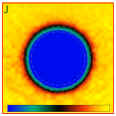 http://nicmosis.as.arizona.edu:8000/POSTERS/TOM1999.jpg
http://nicmosis.as.arizona.edu:8000/POSTERS/TOM1999.jpg
Poster on the 1999 transit of Mercury "definitively solves the problem of
the black-drop effect that plagued past transits of Venus;" by Jay
Pasachoff,
Glenn Schneider and Leon Golub; from the American Astronomical Society's Division
of Planetary Science meeting in 2001.
http://www.williams.edu/astronomy/eclipse/transitVenus.htm
Jay Pasachoff's site links to transit of Venus interests.
http://www.aas.org/publications/baas/v32n4/aas197/785.htm
Abstract describes physical cause of "black drop" effect; B. E.
Schaefer (Univ. Texas Austin) at 2001 AAS meeting.
 http://www.transitsearch.org
http://www.transitsearch.org
An observing program whose purpose is "to coordinate and direct a
cooperative observational effort which will allow experienced amateur
astronomers and small college observatories to discover transiting extrasolar
planets."
http://www.dsellers.demon.co.uk/venus/ven_ch8.htm
Edmond Halley's admonition of 1716, in which he proposes a method to determine
solar parallax and measure the distance to the sun by timing a transit of Venus
from multiple sites across the globe.
 http://carnap.umd.edu/phil250/transits/transits.html
http://carnap.umd.edu/phil250/transits/transits.html
Images related to determining the distance of the earth to the sun; "black
drop" effect illustrations.
 http://home.att.net/~o.caimi/Venus.html
http://home.att.net/~o.caimi/Venus.html
"The Transit of Venus" by David Murray; from December 8, 1874, Scribner's.
"Astronomy, The Transit of Venus" by Gillet and Rolfe, 1882.
http://home.hetnet.nl/~smvanroode/venustransit/ball.pdf
Detailed math excerpted from Robert Stawell Ball's Treatise
on Spherical Astronomy, 1908, addresses the conditions under which a transit
takes place; variations of the sun's path as seen from different points on the
earth; and both Halley's and De Lisle's methods for applying a transit of Venus
to determine the Astronomical Unit (A.U.)
http://sunearth.gsfc.nasa.gov/eclipse/transit/catalog/Visible.html
Formulas and data to show how to calculate whether the transit is visible from
any given location; from Fred Espenak.
http://libnova.sourceforge.net/group__venus.html
Calculation engines for C / C++ programmers, astronomers and anyone else
interested in calculating positions of astronomical objects; from free software libnova,
a general purpose, double precision, astronomical calculation library.
http://www.ssec.wisc.edu/~sanjayl/planets/venus.htm
Site suggests "early measurements of the speed of light were derived from
observations of the transit of Venus..."
http://www.lpl.arizona.edu/~rhill/alpo/transit.html
Notes from the Mercury/Venus Transit Section of the Association of Lunar and
Planetary Observers.
 http://chandra.harvard.edu/photo/cycle1/venus/index.html
http://chandra.harvard.edu/photo/cycle1/venus/index.html
Venus in X-ray; images by Chandra observatory.
 http://www.seds.org/nineplanets/nineplanets/venus.html
http://www.seds.org/nineplanets/nineplanets/venus.html
General background on Venus; from SEDS (Students for the Exploration and
Development of Space).
http://nssdc.gsfc.nasa.gov/planetary/planets/venuspage.html
Venus page from NSSDC (National Space Science Data Center); includes
missions, data on CD ROM, and links.
 http://nssdc.gsfc.nasa.gov/photo_gallery/photogallery-venus.html
http://nssdc.gsfc.nasa.gov/photo_gallery/photogallery-venus.html
Photo gallery of Venus; from NSSDC.
 http://nssdc.gsfc.nasa.gov/planetary/magellan.html
http://nssdc.gsfc.nasa.gov/planetary/magellan.html
Magellan mission to Venus.
 http://www.aoc.nrao.edu/pr/gbtfirstsci.html
http://www.aoc.nrao.edu/pr/gbtfirstsci.html
New radio telescope in West Virginia images Venus first; from National Radio
Astronomy Observatory (NRAO).
 http://www.solarphysics.kva.se/
http://www.solarphysics.kva.se/
Institute for Solar Physics captures the 2003 May 7 transit of Mercury.
 http://www.heavens-above.com
http://www.heavens-above.com
Distinguishes between "transit
of one body in front of another" and "meridian
transit;" plus a lot of other great stuff at this website.
http://www.seds.org/pub/info/newsletters/ejasa/1993/jasa9302.txt
http://www.seds.org/pub/info/newsletters/ejasa/1993/jasa9303.txt
http://www.seds.org/pub/info/newsletters/ejasa/1993/jasa9304.txt
Three-part series on the Soviet and American exploration of Venus, appearing
in the electronic Journal of the Astronomical Society of the Atlantic; by Larry
Klaes.
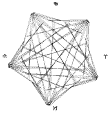 http://www.glenn.freehomepage.com/writings/Pentacle/
http://www.glenn.freehomepage.com/writings/Pentacle/
"Pi, Phi, and the Pentacle" features the five-point pattern derived
from the aligning orbits of Venus and earth; from Glenn R. Smith.
 http://www.transit-of-venus.org.uk/science.htm
http://www.transit-of-venus.org.uk/science.htm
Using parallax to measure distance; from University of Central Lancashire.
http://solareclipsewebpages.users.btopenworld.com/SENL_files/SENL.html
Solar Eclipse Newsletter features listserv discussions about solar events.
As June 2004 nears, several discussions address the transit of Venus, ranging
from technical to travel.
![[Venus]](venus-usgs.gif) http://planetarynames.wr.usgs.gov/venus/venuTOC.html
http://planetarynames.wr.usgs.gov/venus/venuTOC.html
The origins of the names of Venus features are listed by the U.S. Geological
Survey.
Transit Geometry Calculations
(Courtesy of Sten Odenwald and Lou Mayo, Goddard Space Flight Center)
1. ANGULAR SIZE OF VENUS:
Distance to Venus = d ~ 0.277 AU ~ 4.155e7 km
Diameter of Venus = D = 12,100km
Angular Diameter = a = D/d (radians) = 2.9215e-4 radians ~ 60".3
(which is very close to the published value of 58".6)
2. ORBITAL VELOCITY
Venus average orbital velocity = v = 35.02 km/s (max = 35.26, min = 34.79).
Venus transits the sun at a solar latitude of about 60 degrees and takes about 6
hours to transit. Assume at 60 degrees solar latitude, Venus follows a path that
is about 2/3 solar diameter = 0.33 degrees. Then, Venus transits 0.33 degrees of
space in 6 hours, or about 0.055 degrees / hour. This is close to the
calculation of 0.07 degrees / hour and dependent on the length of the chord
(Venus' path) across the sun.
3. From Earth, Venus is at inferior conjunction. From Venus, Earth is at
opposition.
 http://video.google.com/videoplay?docid=-760141133217062403&q=transit+venus
http://video.google.com/videoplay?docid=-760141133217062403&q=transit+venus
NASA Connect offers lessons and exercises on scaling the solar system.
